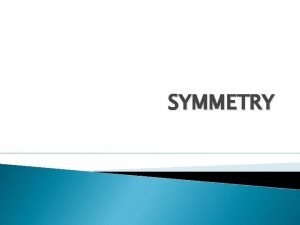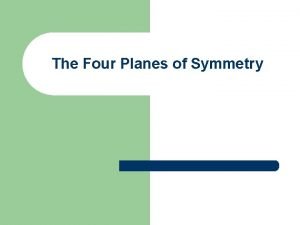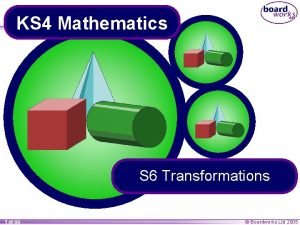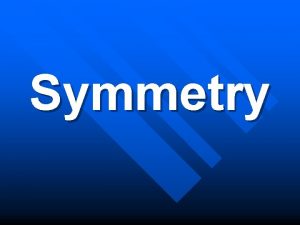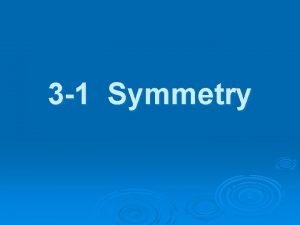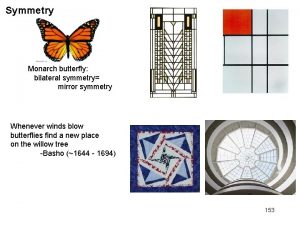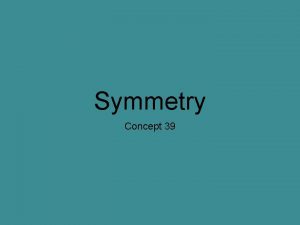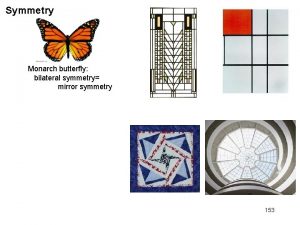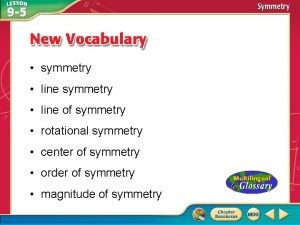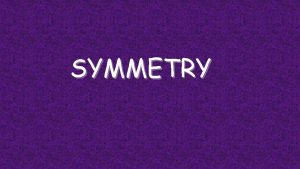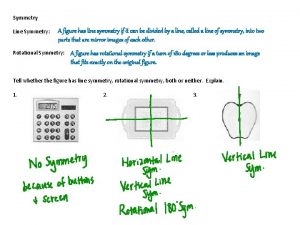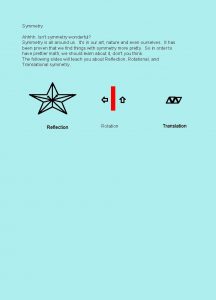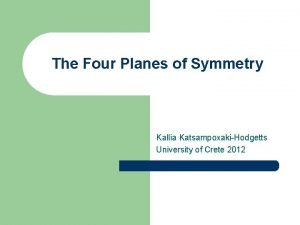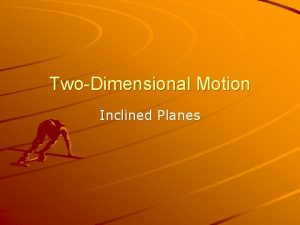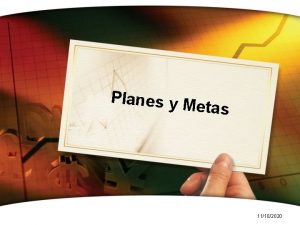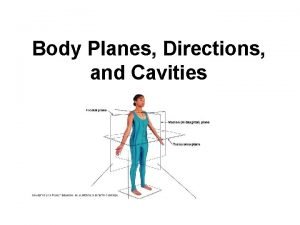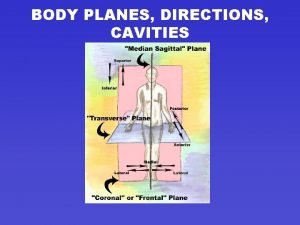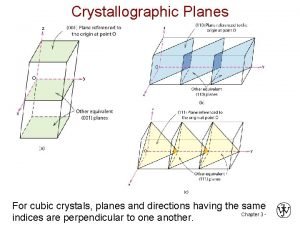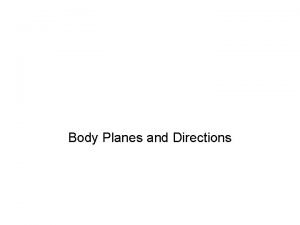The Four Planes of Symmetry Symmetry l A
































- Slides: 32

The Four Planes of Symmetry

Symmetry l A repeating pattern in a plane. A pattern is symmetric if there is at least one symmetry that leaves the pattern unchanged.

Symmetries l In mathematics, the idea of symmetry gives us a precise way to think about this subject. We will talk about plane symmetries, those that take place on a flat plane, but the ideas generalize to spatial symmetries too.

Types of Symmetry l l Translation Rotation Glide Reflection

Translation

Translation Properties l A translation is defined by its direction and/or distance. Two objects are symmetrical under translation if one can be superimposed on the other such that their edges match up perfectly.

A translation l l It is a shape that is simply translated, or slid, across the paper and drawn again in another place. It shows the geometric shape in the same alignment as the original; it does not turn or flip.

Rotation To rotate an object means to turn it around. Every rotation has a center and an angle.

Rotational Symmetry l l Rotation is spinning the pattern around a point, rotating it. A rotation, or turn, occurs when an object is moved in a circular fashion around a central point (i, . e origin) which does not move. Formally, rotational symmetry is symmetry with respect to some or all rotations in m-dimensional Euclidean space. Rotations are direct isometries, i. e. , isometries preserving orientation.

Rotation

Symmetrical object under Rotation l It appears the same when rotated about its center some fraction of 360 degrees. The most common types of rotational symmetries are 90 and 180 degree rotations, but others such as 45 and 60 also occur. For example, the number "6" is symmetrical to the number "9" under 180 -degree rotation.

Reflectional Symmetry l l l Reflection symmetry, line symmetry, mirror-image symmetry, or bilateral symmetry is symmetry with respect to reflection. A type of symmetry in which one half of the object is the mirror image of the other. In 2 D there is a line of symmetry, in 3 D a plane of symmetry. An object or figure which is indistinguishable from its transformed image is called mirror symmetric.

Reflection Symmetry about a vertical line of reflection.

The hexagon has reflectional symmetry about both horizontal and vertical lines of reflection.

Related Terms for Reflectional Symmetry l l l Flip Horizontal Line Vertical Line Mirror Symmetry Reflection symmetry, line symmetry, mirror-image symmetry, or bilateral symmetry is symmetry with respect to reflection.

Properties of Reflections Betweenness Angle measure Distance --length or linear measure Reverse orientation Collinearity

Collinearity the property of lying on a single line: Example: l The orthocenter, the circumcenter, the centroid, the Exeter point, and the center of the nine-point circle are collinear, all falling on a line called the Euler line.

Solve a Problem The letter B has reflectional symmetry. Identify the list of other alphabets with similar reflection. Choices: 1. A, H, I, M, O, T, U, W, X, Y 2. C, D, E, H, I, O, X 3. F, G, J, L, Q, R, S, Z 4. A, C, D, E, H, I, K, M, O, T, U, X, Y

Steps before the Solution l Step 1: A reflection flips the figure across a line. The new figure is a mirror image of the original figure. Step 2: The alphabet 'B' has horizontal reflection because half a figure is a mirror image of the other half.

Solution l The other alphabets with similar reflection are C, D, E, H, I, O, X.

Glide Reflection

Glide Reflection l l combination of two symmetries (reflection with a translation along the direction of the mirror line) involves more than one step

Glide Reflections

In glide reflection, l Reflection and translation are used concurrently much like the following piece by Escher, Horseman. There is no reflectional symmetry, nor is there rotational symmetry.

Tesselations l l If you look at a completed tessellation, you will see the original motif repeats in a pattern. One mathematical idea that can be emphasized through tessellations is symmetry. There are 17 possible ways that a pattern can be used to tile a flat surface or 'wallpaper'.

Find the symmetry


References l l http: //math. hws. edu/eck/math 110_s 08/symmetries/index. html http: //mathforum. org/sum 95/suzanne/symsusan. html http: //www. csun. edu/~lmp 99402/Math_Art/Tesselations/tesselat ions. html http: //www. ehow. com/info_8465413_different-kinds-symmetries -math. html

Task 1: True or False? l l Plane symmetry means a symmetry of a pattern in the Euclidean plane; that is, a transformation of the plane that carries any directioned lines to lines and preserves many different distances. A pattern is symmetric if there is at least one symmetry that leaves the pattern changed. In 2 D and 3 D there is a plane of symmetry. An object or figure which is indistinguishable from its transformed image is called mirror.

Task 2: Complete the gaps 1. An object that is symmetrical under reflection is the ………. . of the other object. Objects with reflectional symmetry are categorized by the ………. of the axis of symmetry: vertical, horizontal or slant. For example, the letter "W" has reflectional symmetry with the letter "M" along a ………axis. • Rotation is ……. the pattern around a point, rotating it. A rotation, or turn, occurs when an object is moved in a …………. . around a central point which does not move. • Symmetry under translation refers to simply moving the object horizontally, vertically or both ………rotating or reflecting it. A translation is defined by its direction and/or…. . Two objects are symmetrical under translation if one can be ………. on the other such that their edges match up perfectly. It shows the geometric shape in the same a……. . as the original; it does not flip • ……reflection is the only type of symmetry that is a …. . . . of two symmetries. Two objects are symmetrical under glide reflection if one is a reflection of the other and is translated ……………. the axis of symmetry.

Task 4 Plane symmetry involves moving all points …. the plane so that their positions relative …. each other remain the same, although their absolute positions may change. Symmetries preserve distances, angles, sizes, and shapes. For example, rotation …. . 90 degrees …. . a fixed point is an example …. a plane symmetry. Another basic type of symmetry is a reflection. The reflection of a figure …. the plane ……. . a line moves its reflected image …. where it would appear if you viewed it using a mirror placed …. the line. Another way …. make a reflection is to fold a piece of paper and trace the figure ……. the other side of the fold. A third type of symmetry is translation. Translating an object means moving it without rotating or reflecting it. You can describe a translation …… stating how far it moves an object, and …… what direction. The fourth (and last) type of symmetry is a glide reflection. A glide reflection combines a reflection …… a translation ……. . the direction of the mirror line.

Task 3: Dictogloss Step 1: Listen to the instructor reading a short text on the four planes of symmetry and take notes. Step 2: Reconstruct the text after comparing notes with a partner.
 Rotational symmetry of cuboid
Rotational symmetry of cuboid A transformation with a line of symmetry
A transformation with a line of symmetry Planes of symmetry
Planes of symmetry Planes of symmetry
Planes of symmetry Lines of symmetry in a square based pyramid
Lines of symmetry in a square based pyramid How many planes of symmetry does a cuboid have
How many planes of symmetry does a cuboid have Trời xanh đây là của chúng ta thể thơ
Trời xanh đây là của chúng ta thể thơ Bảng số nguyên tố
Bảng số nguyên tố Fecboak
Fecboak đặc điểm cơ thể của người tối cổ
đặc điểm cơ thể của người tối cổ Tỉ lệ cơ thể trẻ em
Tỉ lệ cơ thể trẻ em Các châu lục và đại dương trên thế giới
Các châu lục và đại dương trên thế giới ưu thế lai là gì
ưu thế lai là gì Sơ đồ cơ thể người
Sơ đồ cơ thể người Kể tên các môn thể thao
Kể tên các môn thể thao Tư thế ngồi viết
Tư thế ngồi viết Cái miệng bé xinh thế chỉ nói điều hay thôi
Cái miệng bé xinh thế chỉ nói điều hay thôi Hát kết hợp bộ gõ cơ thể
Hát kết hợp bộ gõ cơ thể Cách giải mật thư tọa độ
Cách giải mật thư tọa độ Tư thế ngồi viết
Tư thế ngồi viết Voi kéo gỗ như thế nào
Voi kéo gỗ như thế nào Thẻ vin
Thẻ vin V cc
V cc Thơ thất ngôn tứ tuyệt đường luật
Thơ thất ngôn tứ tuyệt đường luật Các châu lục và đại dương trên thế giới
Các châu lục và đại dương trên thế giới Từ ngữ thể hiện lòng nhân hậu
Từ ngữ thể hiện lòng nhân hậu Sự nuôi và dạy con của hổ
Sự nuôi và dạy con của hổ Thế nào là hệ số cao nhất
Thế nào là hệ số cao nhất Diễn thế sinh thái là
Diễn thế sinh thái là Vẽ hình chiếu vuông góc của vật thể sau
Vẽ hình chiếu vuông góc của vật thể sau 101012 bằng
101012 bằng Lời thề hippocrates
Lời thề hippocrates


